ECU TOYOTA RAV4 PLUG-IN HYBRID 2021 Owners Manual
[x] Cancel search | Manufacturer: TOYOTA, Model Year: 2021, Model line: RAV4 PLUG-IN HYBRID, Model: TOYOTA RAV4 PLUG-IN HYBRID 2021Pages: 666, PDF Size: 161.28 MB
Page 3 of 666
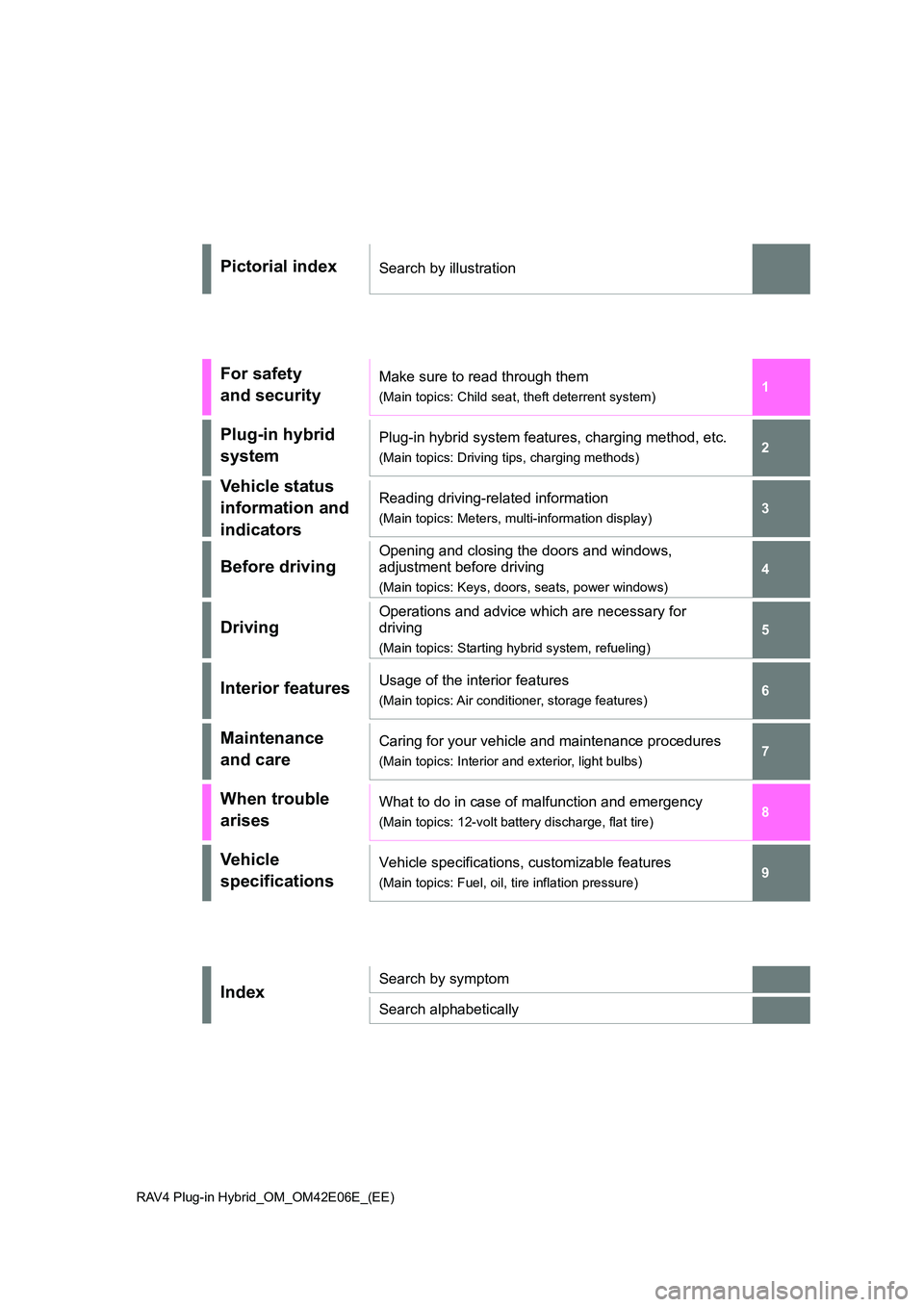
RAV4 Plug-in Hybrid_OM_OM42E06E_(EE)
1
6
5
4
3
2
8
7
9
Pictorial indexSearch by illustration
For safety
and security
Make sure to read through them
(Main topics: Child seat, theft deterrent system)
Plug-in hybrid
system
Plug-in hybrid system features, charging method, etc.
(Main topics: Driving tips, charging methods)
Vehicle status
information and
indicators
Reading driving-related information
(Main topics: Meters, multi-information display)
Before driving
Opening and closing the doors and windows,
adjustment before driving
(Main topics: Keys, doors, seats, power windows)
Driving
Operations and advice which are necessary for
driving
(Main topics: Starting hybrid system, refueling)
Interior featuresUsage of the interior features
(Main topics: Air conditioner, storage features)
Maintenance
and care
Caring for your vehicle and maintenance procedures
(Main topics: Interior and exterior, light bulbs)
When trouble
arises
What to do in case of malfunction and emergency
(Main topics: 12-volt battery discharge, flat tire)
Vehicle
specifications
Vehicle specifications, customizable features
(Main topics: Fuel, oil, tire inflation pressure)
IndexSearch by symptom
Search alphabetically
Page 4 of 666
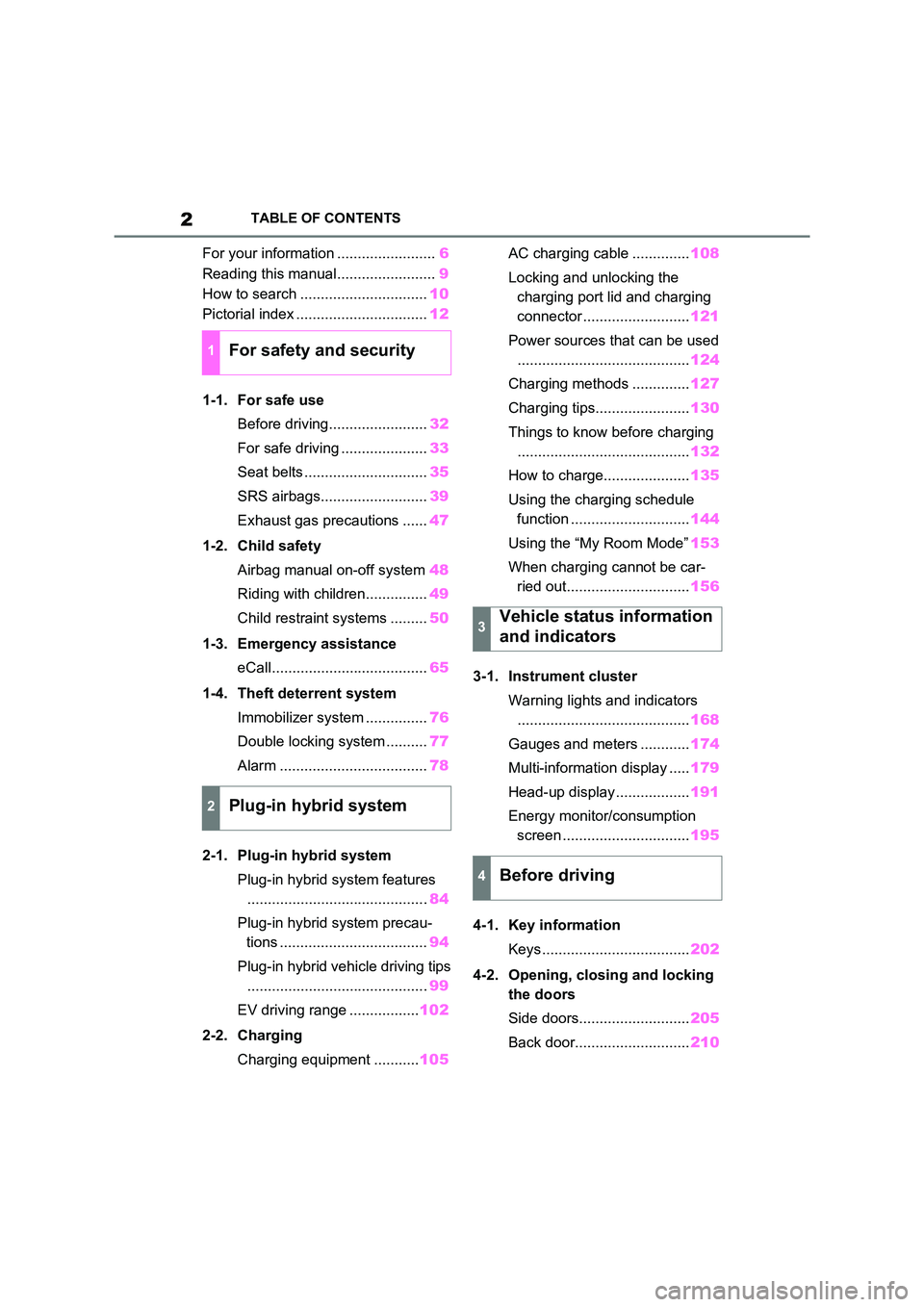
2TABLE OF CONTENTS
For your information ........................6
Reading this manual........................ 9
How to search ............................... 10
Pictorial index ................................ 12
1-1. For safe use
Before driving........................ 32
For safe driving ..................... 33
Seat belts .............................. 35
SRS airbags.......................... 39
Exhaust gas precautions ...... 47
1-2. Child safety
Airbag manual on-off system 48
Riding with children............... 49
Child restraint systems ......... 50
1-3. Emergency assistance
eCall...................................... 65
1-4. Theft deterrent system
Immobilizer system ............... 76
Double locking system .......... 77
Alarm .................................... 78
2-1. Plug-in hybrid system
Plug-in hybrid system features
............................................ 84
Plug-in hybrid system precau -
tions .................................... 94
Plug-in hybrid vehicle driving tips
............................................ 99
EV driving range ................. 102
2-2. Charging
Charging equipment ........... 105
AC charging cable .............. 108
Locking and unlocking the
charging port lid and charging
connector .......................... 121
Power sources that can be used
.......................................... 124
Charging methods .............. 127
Charging tips....................... 130
Things to know before charging
.......................................... 132
How to charge..................... 135
Using the charging schedule
function ............................. 144
Using the “My Room Mode” 153
When charging cannot be car -
ried out.............................. 156
3-1. Instrument cluster
Warning lights and indicators
.......................................... 168
Gauges and meters ............ 174
Multi-information display ..... 179
Head-up display .................. 191
Energy monitor/consumption
screen ............................... 195
4-1. Key information
Keys .................................... 202
4-2. Opening, clo sing and locking
the doors
Side doors........................... 205
Back door............................ 210
1For safety and security
2Plug-in hybrid system
3Vehicle status information
and indicators
4Before driving
Page 33 of 666
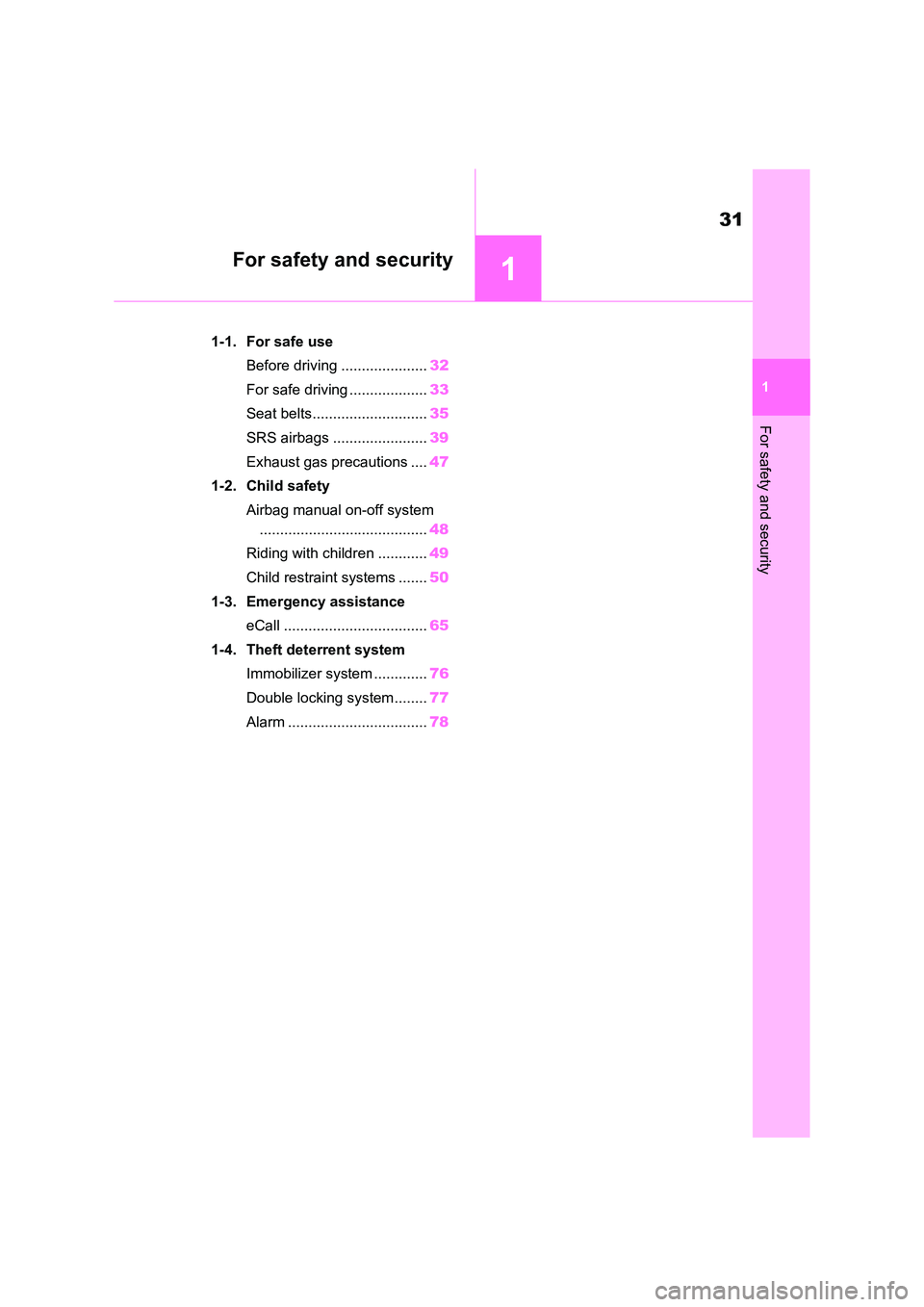
1
31
1
For safety and security
For safety and security
1-1. For safe use
Before driving ..................... 32
For safe driving ................... 33
Seat belts............................ 35
SRS airbags ....................... 39
Exhaust gas precautions .... 47
1-2. Child safety
Airbag manual on-off system
......................................... 48
Riding with children ............ 49
Child restraint systems ....... 50
1-3. Emergency assistance
eCall ................................... 65
1-4. Theft deterrent system
Immobilizer system ............. 76
Double locking system ........ 77
Alarm .................................. 78
Page 34 of 666
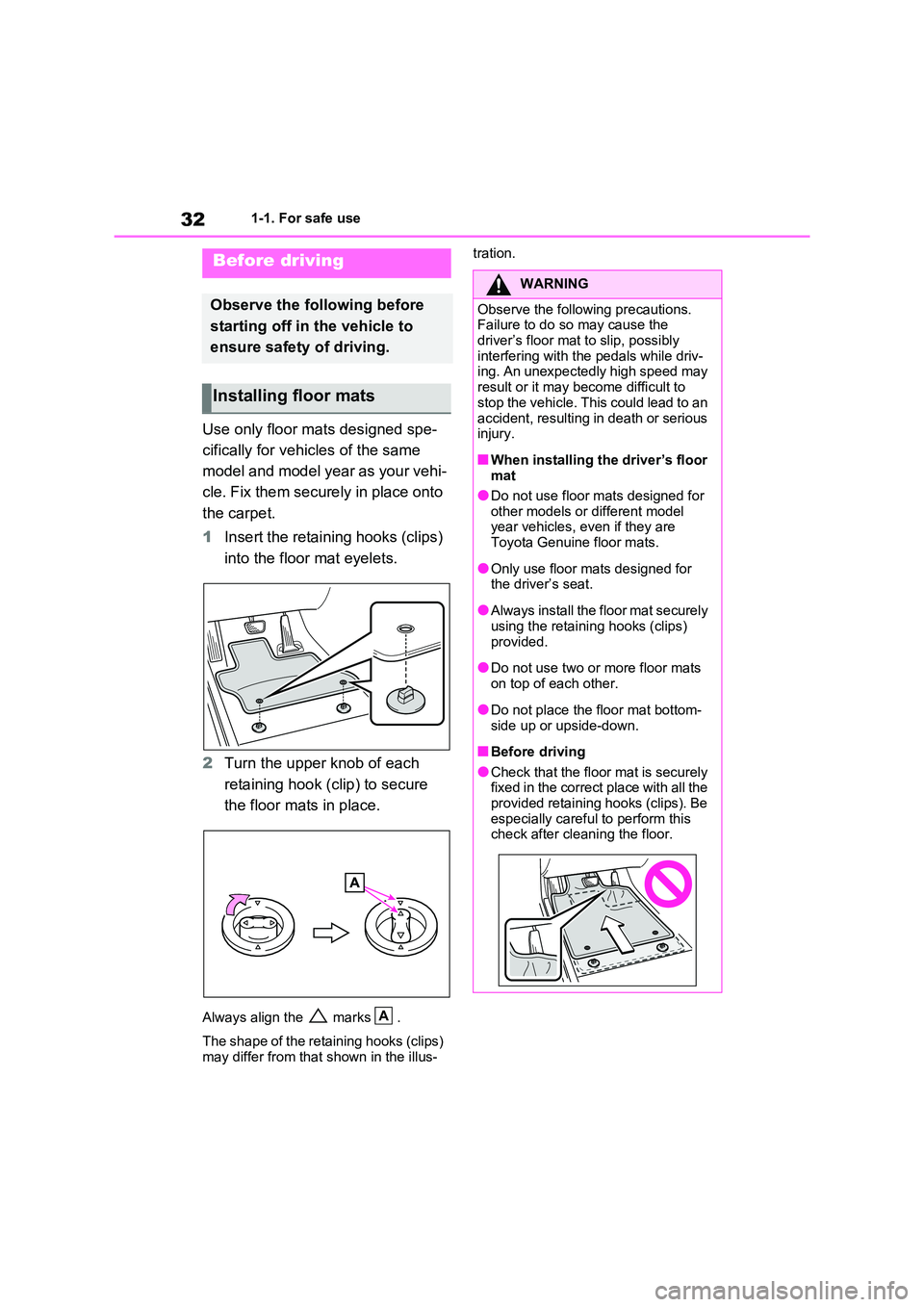
321-1. For safe use
1-1.For safe use
Use only floor mats designed spe-
cifically for vehicles of the same
model and model year as your vehi -
cle. Fix them securely in place onto
the carpet.
1 Insert the retaining hooks (clips)
into the floor mat eyelets.
2 Turn the upper knob of each
retaining hook (clip) to secure
the floor mats in place.
Always align the marks .
The shape of the retaining hooks (clips)
may differ from that shown in the illus-
tration.Before driving
Observe the following before
starting off in the vehicle to
ensure safety of driving.
Installing floor mats
A
WARNING
Observe the following precautions. Failure to do so may cause the
driver’s floor mat to slip, possibly
interfering with t he pedals while driv- ing. An unexpectedly high speed may
result or it may become difficult to
stop the vehicle. This could lead to an
accident, resulting in death or serious injury.
■When installing the driver’s floor mat
●Do not use floor ma ts designed for
other models or different model year vehicles, e ven if they are
Toyota Genuine floor mats.
●Only use floor mats designed for
the driver’s seat.
●Always install the floor mat securely
using the retainin g hooks (clips)
provided.
●Do not use two or more floor mats
on top of each other.
●Do not place the f loor mat bottom-
side up or upside-down.
■Before driving
●Check that the floor mat is securely fixed in the correct place with all the
provided retaining hooks (clips). Be
especially careful to perform this check after cleaning the floor.
Page 35 of 666
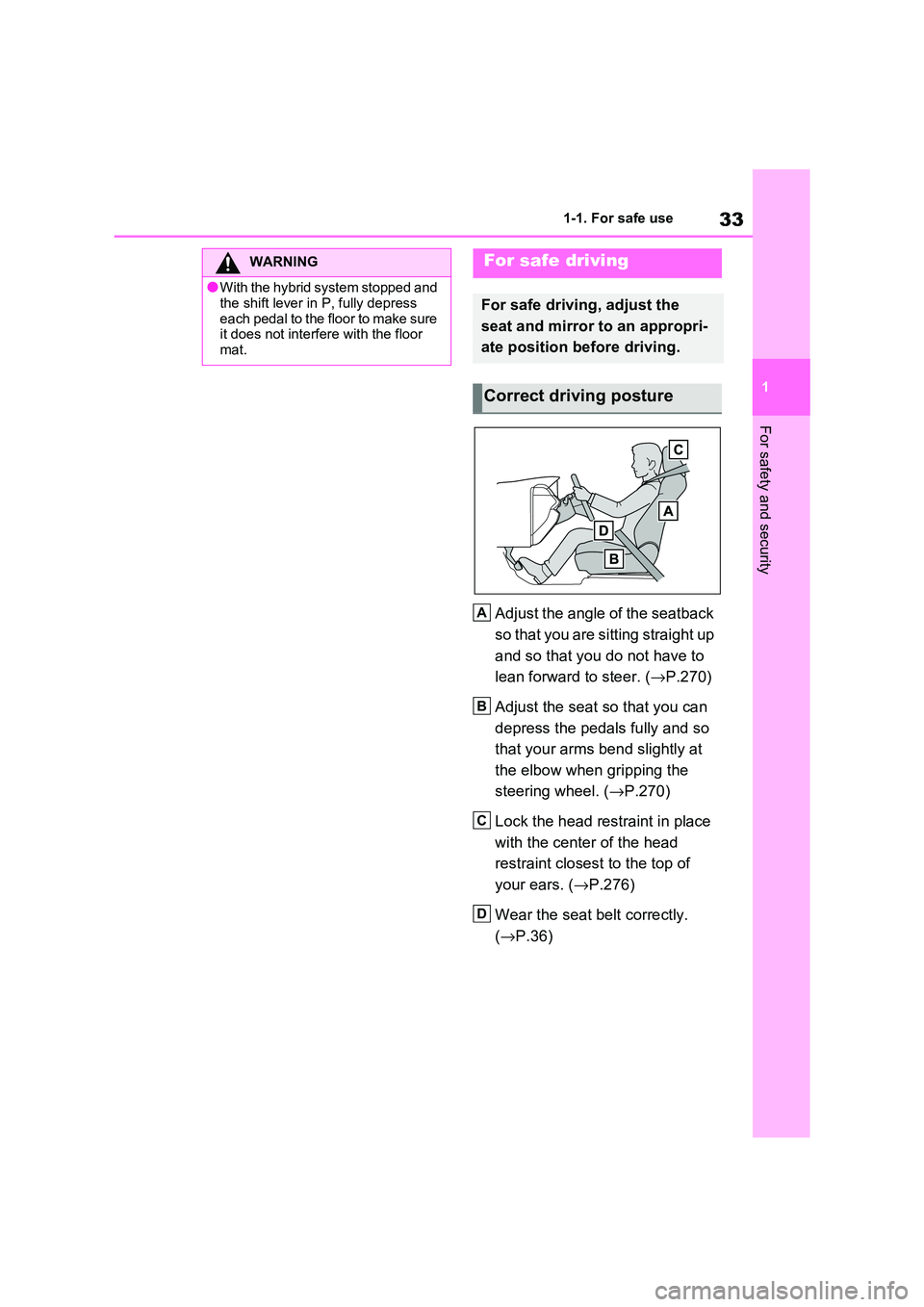
33
1
1-1. For safe use
For safety and security
Adjust the angle of the seatback
so that you are sitting straight up
and so that you do not have to
lean forward to steer. ( →P.270)
Adjust the seat so that you can
depress the pedals fully and so
that your arms bend slightly at
the elbow when gripping the
steering wheel. ( →P.270)
Lock the head restraint in place
with the center of the head
restraint closest to the top of
your ears. ( →P.276)
Wear the seat belt correctly.
( →P.36)
WARNING
●With the hybrid system stopped and
the shift lever in P, fully depress
each pedal to the floor to make sure it does not interfere with the floor
mat.
For safe driving
For safe driving, adjust the
seat and mirror to an appropri -
ate position before driving.
Correct driving posture
A
B
C
D
Page 37 of 666
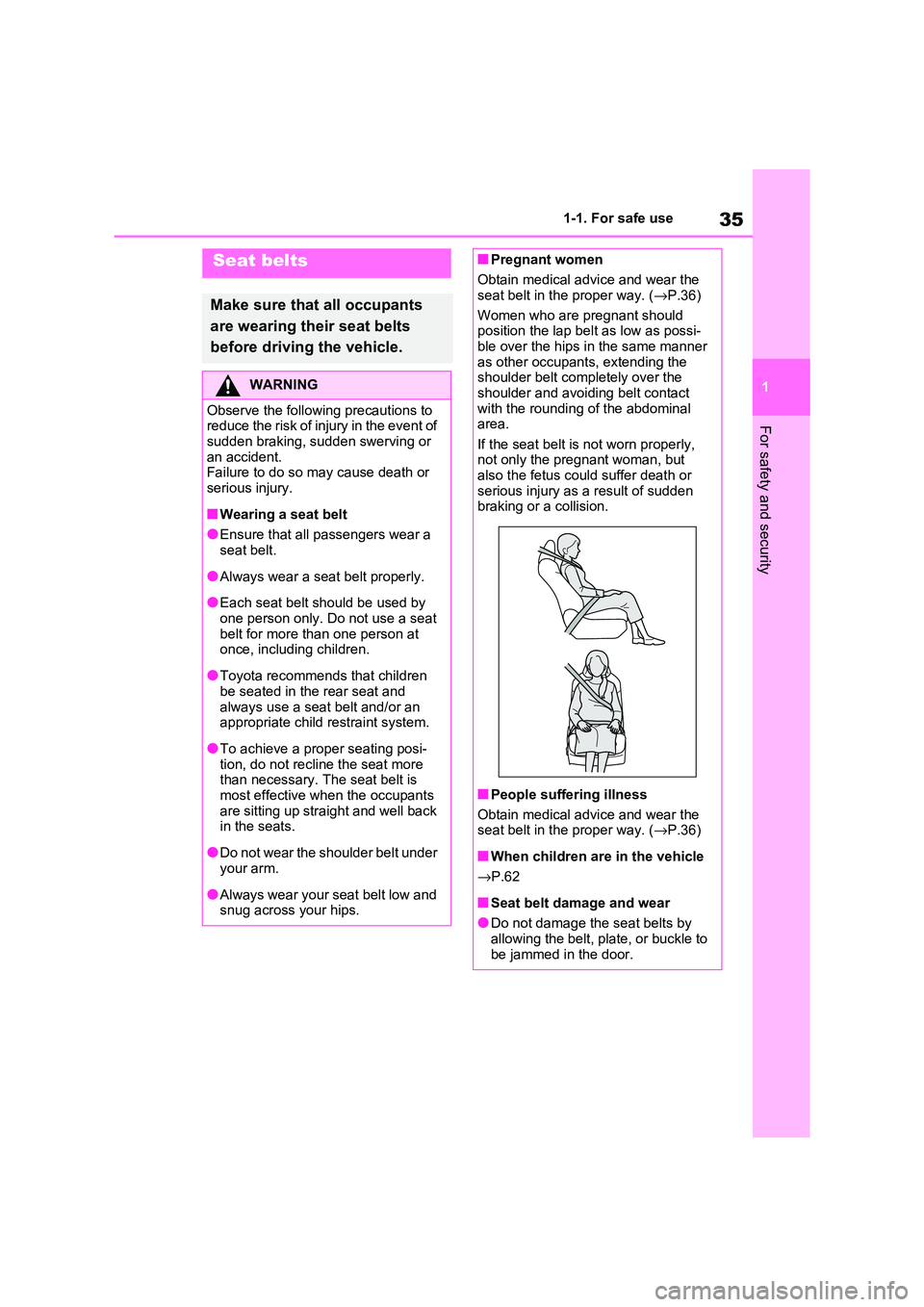
35
1
1-1. For safe use
For safety and security
Seat belts
Make sure that all occupants
are wearing th eir seat belts
before driving the vehicle.
WARNING
Observe the following precautions to
reduce the risk of injury in the event of
sudden braking, sudden swerving or an accident.
Failure to do so m ay cause death or
serious injury.
■Wearing a seat belt
●Ensure that all passengers wear a seat belt.
●Always wear a seat belt properly.
●Each seat belt should be used by
one person only. Do not use a seat belt for more t han one person at
once, includin g children.
●Toyota recommends that children
be seated in the rear seat and
always use a sea t belt and/or an appropriate child restraint system.
●To achieve a proper seating posi - tion, do not recline the seat more
than necessary. The seat belt is
most effective when the occupants are sitting up straight and well back
in the seats.
●Do not wear the shoulder belt under
your arm.
●Always wear your seat belt low and
snug across your hips.
■Pregnant women
Obtain medical advice and wear the
seat belt in the proper way. ( →P.36)
Women who are pregnant should position the lap belt as low as possi -
ble over the hips in the same manner
as other occupants, extending the shoulder belt completely over the
shoulder and avoiding belt contact
with the rounding of the abdominal area.
If the seat belt is not worn properly,
not only the pregnant woman, but also the fetus coul d suffer death or
serious injury as a result of sudden
braking or a collision.
■People suffering illness
Obtain medical advice and wear the
seat belt in the proper way. ( →P.36)
■When children are in the vehicle
→ P.62
■Seat belt damage and wear
●Do not damage the seat belts by
allowing the belt, plate, or buckle to be jammed in the door.
Page 39 of 666
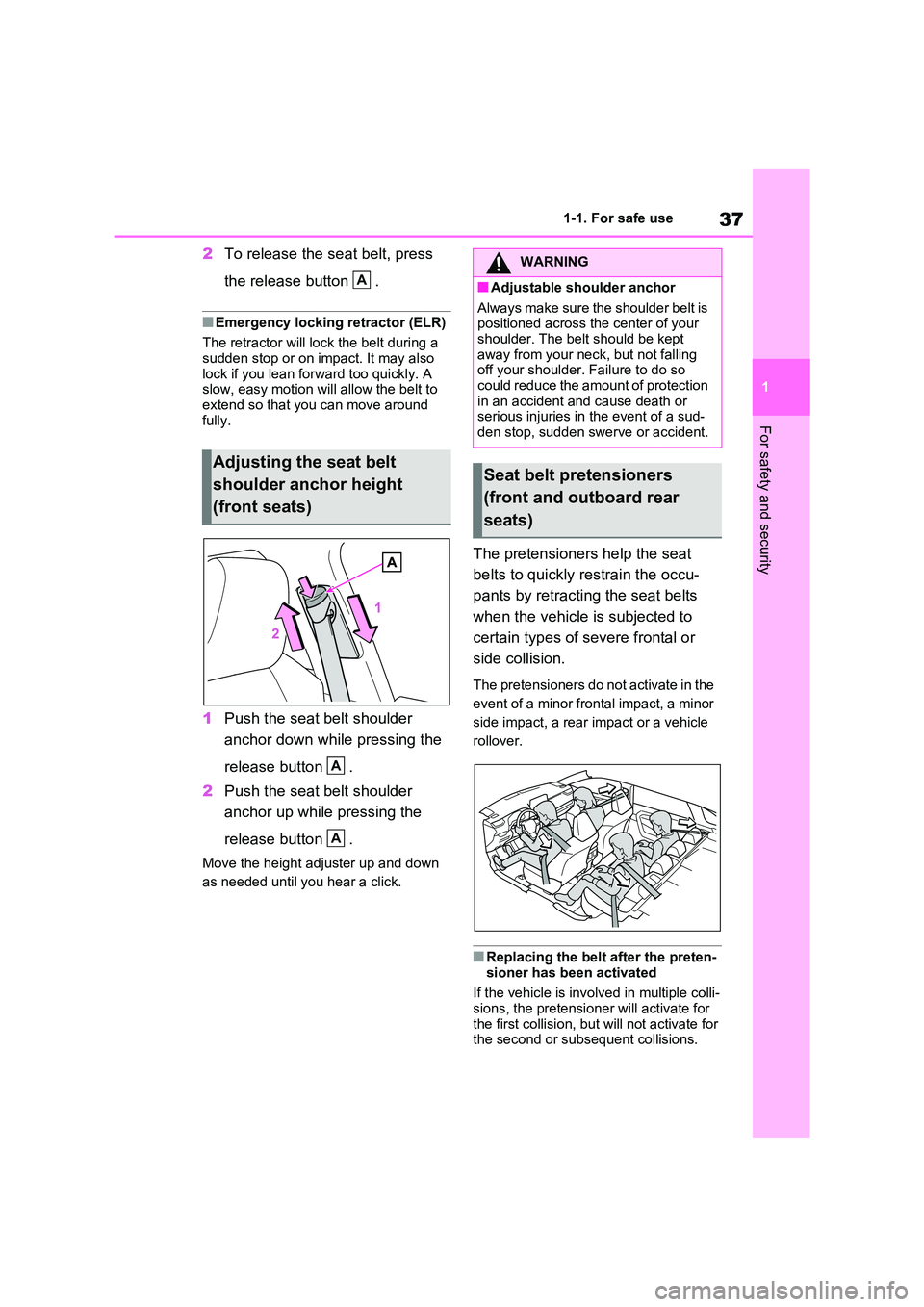
37
1
1-1. For safe use
For safety and security
2 To release the seat belt, press
the release button .
■Emergency locking retractor (ELR)
The retractor will lo ck the belt during a
sudden stop or on impact. It may also
lock if you lean forw ard too quickly. A slow, easy motion will allow the belt to
extend so that you can move around
fully.
1 Push the seat belt shoulder
anchor down while pressing the
release button .
2 Push the seat belt shoulder
anchor up while pressing the
release button .
Move the height adjuster up and down
as needed until you hear a click.
The pretensioners help the seat
belts to quickly restrain the occu -
pants by retracting the seat belts
when the vehicle is subjected to
certain types of severe frontal or
side collision.
The pretensioners do not activate in the
event of a minor frontal impact, a minor
side impact, a rear impact or a vehicle
rollover.
■Replacing the belt after the preten- sioner has been activated
If the vehicle is invol ved in multiple colli-
sions, the pretensioner will activate for the first collision, but will not activate for
the second or subsequent collisions.
Adjusting the seat belt
shoulder anchor height
(front seats)
A
A
A
�:�$�5�1�,�1�*
■Adjustable shoulder anchor
Always make sure the shoulder belt is
positioned across the center of your shoulder. The belt should be kept
away from your neck, but not falling
off your shoulder. Failure to do so could reduce the amount of protection
in an accident and cause death or
serious injuries in the event of a sud -
den stop, sudden swerve or accident.
Seat belt pretensioners
(front and outboard rear
seats)
Page 41 of 666
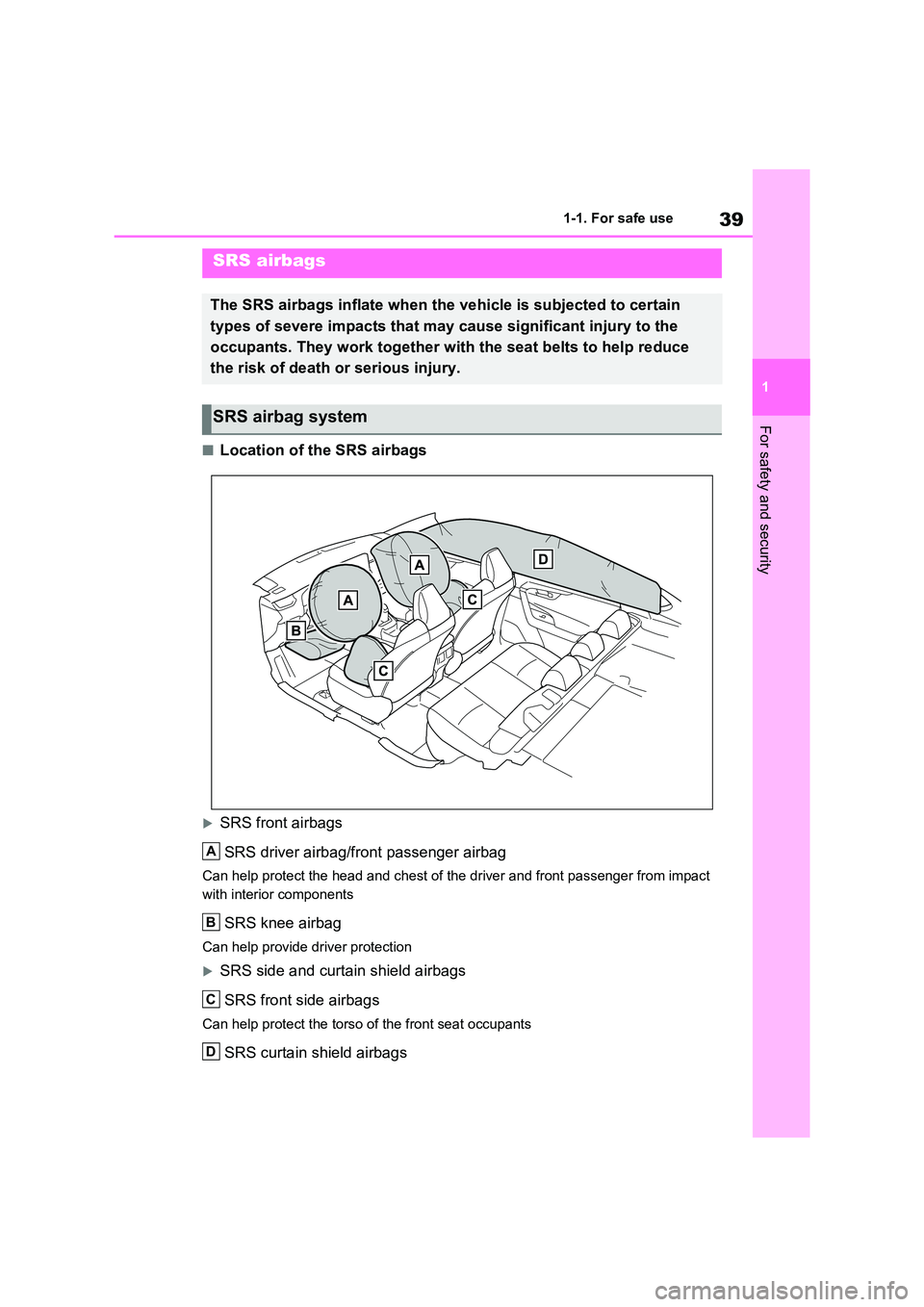
39
1
1-1. For safe use
For safety and security
■Location of the SRS airbags
SRS front airbags
SRS driver airbag/front passenger airbag
Can help protect the head and chest of the driver and front passenger from impact
with interior components
SRS knee airbag
Can help provide driver protection
SRS side and curtai n shield airbags
SRS front side airbags
Can help protect the torso of the front seat occupants
SRS curtain shield airbags
SRS airbags
The SRS airbags inflate when the vehicle is subjected to certain
types of severe impacts that may cause significant injury to the
occupants. They work together with the seat belts to help reduc e
the risk of death o r serious injury.
SRS airbag system
A
B
C
D
Page 43 of 666
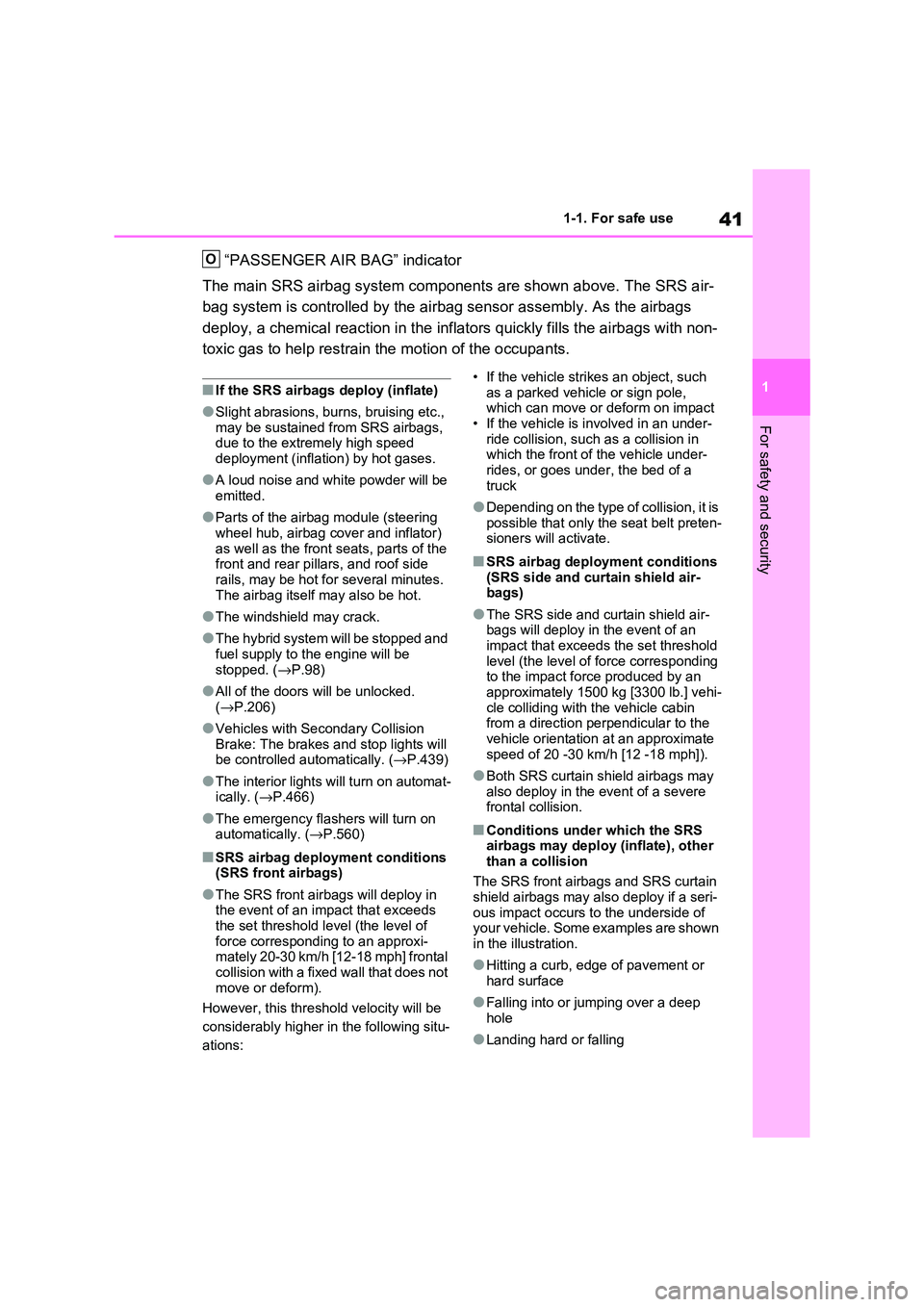
41
1
1-1. For safe use
For safety and security
“PASSENGER AIR BAG” indicator
The main SRS airbag system comp onents are shown above. The SRS air-
bag system is controlled by the airbag sensor assembly. As the airbags
deploy, a chemical reaction in t he inflators quickly fills the airbags with non-
toxic gas to help restrain t he motion of the occupants.
■If the SRS airbags deploy (inflate)
●Slight abrasions, burns, bruising etc.,
may be sustained from SRS airbags, due to the extrem ely high speed
deployment (inflation) by hot gases.
●A loud noise and white powder will be
emitted.
●Parts of the airbag module (steering
wheel hub, airbag cover and inflator)
as well as the fron t seats, parts of the front and rear pillars, and roof side
rails, may be hot for several minutes.
The airbag itself m ay also be hot.
●The windshield may crack.
●The hybrid system will be stopped and
fuel supply to t he engine will be
stopped. ( →P.98)
●All of the doors will be unlocked.
( →P.206)
●Vehicles with Secondary Collision
Brake: The brakes and stop lights will be controlled au tomatically. (→P.439)
●The interior lights will turn on automat- ically. ( →P.466)
●The emergency flashers will turn on automatically. ( →P.560)
■SRS airbag deployment conditions
(SRS front airbags)
●The SRS front airb ags will deploy in
the event of an impact that exceeds
the set threshold level (the level of force corresponding to an approxi -
mately 20-30 km/h [12-18 mph] frontal
collision with a fixed wall that does not move or deform).
However, this threshold velocity will be
considerably higher in the following situ -
ations:
• If the vehicle strikes an object, such as a parked vehicle or sign pole,
which can move or deform on impact
• If the vehicle is involved in an under -
ride collision, such as a collision in which the front of the vehicle under -
rides, or goes under , the bed of a
truck
●Depending on the type of collision, it is
possible that only the seat belt preten - sioners will activate.
■SRS airbag deployment conditions
(SRS side and cu rtain shield air-
bags)
●The SRS side and curtain shield air -
bags will deploy in the event of an impact that exceeds the set threshold
level (the level of force corresponding
to the impact forc e produced by an approximately 1500 kg [3300 lb.] vehi -
cle colliding with the vehicle cabin
from a direction perpendicular to the vehicle orientation at an approximate
speed of 20 -30 km/h [12 -18 mph]).
●Both SRS curtain shield airbags may
also deploy in the event of a severe
frontal collision.
■Conditions under which the SRS airbags may deploy (inflate), other
than a collision
The SRS front airbags and SRS curtain shield airbags may a lso deploy if a seri-
ous impact occurs to the underside of
your vehicle. Some e xamples are shown in the illustration.
●Hitting a curb, edge of pavement or hard surface
●Falling into or jumping over a deep hole
●Landing hard or falling
O
Page 45 of 666
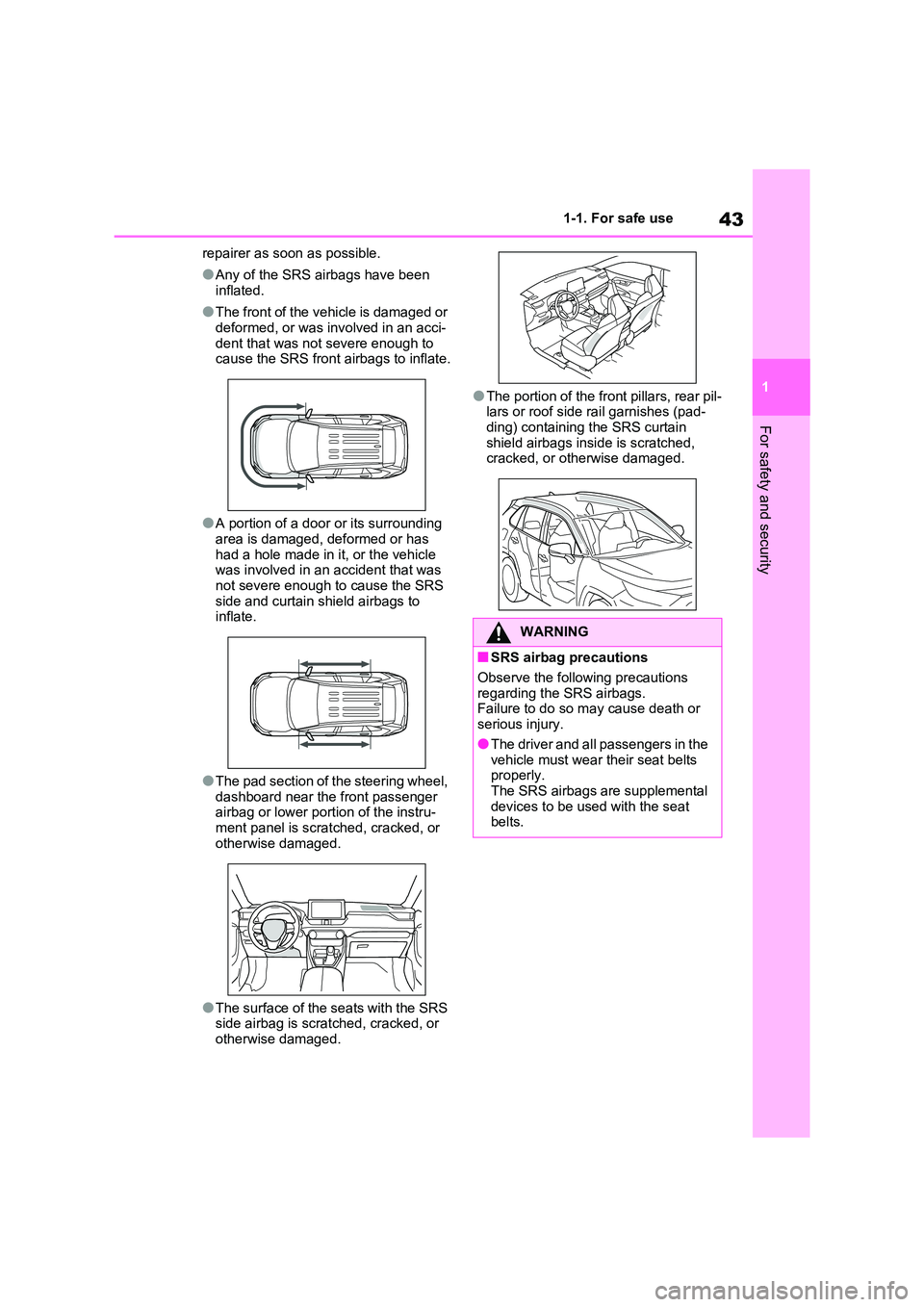
43
1
1-1. For safe use
For safety and security
repairer as soon as possible.
●Any of the SRS airbags have been
inflated.
●The front of the vehicle is damaged or
deformed, or was involved in an acci -
dent that was no t severe enough to cause the SRS front airbags to inflate.
●A portion of a door or its surrounding area is damaged, deformed or has
had a hole made in it, or the vehicle
was involved in an accident that was not severe enough to cause the SRS
side and curtain shield airbags to
inflate.
●The pad section of the steering wheel,
dashboard near the front passenger airbag or lower portion of the instru -
ment panel is scratched, cracked, or
otherwise damaged.
●The surface of the seats with the SRS
side airbag is scratched, cracked, or
otherwise damaged.
●The portion of the front pillars, rear pil -
lars or roof side rail garnishes (pad- ding) containing the SRS curtain
shield airbags inside is scratched,
cracked, or otherwise damaged.
WARNING
■SRS airbag precautions
Observe the following precautions
regarding the SRS airbags.
Failure to do so m ay cause death or serious injury.
●The driver and all passengers in the
vehicle must wear their seat belts properly.
The SRS airbags are supplemental
devices to be used with the seat belts.